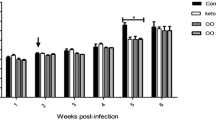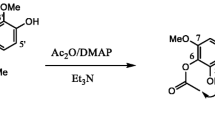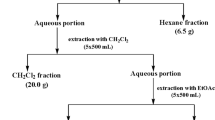Abstract
Leishmaniasis is considered a neglected disease and affects billions around the world, currently presenting few therapeutic options, which makes the development of new antileishmanial drugs urgent. Secondary metabolites from marine and terrestrial organisms are important sources of new chemical entities. Herein, the potential activity of crude extracts and fractions from the Antarctic macroalga Iridaea cordata (Turner) Bory de Saint-Vincent was studied against promastigote and intracellular amastigotes forms of Leishmania amazonensis. The cytotoxicity of the active fractions was evaluated on macrophages and 3T3 BALB/c fibroblasts. The chemical profile of volatile substances was analyzed using the GC-MS technique. The fractions IC-FE (IC50-AMA = 23.6 ± 3.4 μg mL−1; SI > 11) and IC-FF (IC50-AMA = 12.4 ± 1.2 μg mL−1; SI > 24) showed promising activity against amastigotes and higher selectivity to the parasite rather than to the mammalian host cells, when compared to the reference drug amphotericin B (IC50-AMA = 5.9 ± 0.3 μg mL−1; SI = 3.9). Their estimated LD50 in rodents are also higher than that in amphotericin B (LD50 IC-FE = 594.5 ± 25.87 mg kg−1; LD50 IC-FE = 580.1 ± 11.84 mg kg−1; LD50 amphoter = 172.20 ± 2.40 mg kg−1). The chemical profile of these fractions showed the presence of phthalates, esters, ketones, fatty acids, and carboxylic acids, which might be contributing alone or synergistically to the observed antileishmanial activity. Consequently, I. cordata might be used to identify new antileishmanial compounds.



Similar content being viewed by others
References
Aissa I, Sghair RM, Bouaziz M, Laouini D, Sayadi S, Gargouri Y (2012) Synthesis of lipophilic tyrosyl esters derivatives and assessment of their antimicrobial and antileishmania activities. Lipids Health Dis 11:13
Álvarez G, Perdomo C, Coronel C, Aguilera E, Varela J, Aparicio G, Zolessi FR, Cabrera N, Vega C, Rolón M, Rojas de Arias A, Pérez-Montfort R, Cerecetto H, González M (2017) Multi-anti-parasitic activity of arylidene ketones and thiazolidene hydrazines against Trypanosoma cruzi and Leishmania spp. Molecules 22:E709
Becerra M, Boutefnouchet S, Córdoba O, Vitorino GP, Brehu L, Lamour I, Laimay F, Efstathiou A, Smirlis D, Michel S, Kritsanida M, Flores ML, Grougnet R (2015) Antileishmanial activity of fucosterol recovered from Lessonia vadosa Searles (Lessoniaceae) by SFE, PSE and CPC. Phytochem Lett 11:418–423
Borsari C, Santarem N, Torrado J, Olías AI, Corral MJ, Baptista C, Gul S, Wolf M, Kuzikov M, Ellinger B, Witt G, Gribbon P, Reinshagen J, Linciano P, Tait A, Costantino L, Freitas-Junior LH, Moraes CB, Bruno Dos Santos P, Alcântara LM, Franco CH, Bertolacini CD, Fontana V, Tejera Nevado P, Clos J, Alunda JM, Cordeiro-da-Silva A, Ferrari S, Costi MP (2017) Methoxylated 2′-hydroxychalcones as antiparasitic hit compounds. Eur J Med Chem 126:1129–1135
Boylston TD, Viniyard BT (1998) Isolation of volatile flavor compounds from peanut butter using purge-and-trap technique. In: Wetzel, DLB, Charalambous, G (eds), Developments in Food Science, vol 39. Elsevier, Heidelberg, pp 225–243
CDC Centers for Disease Control and Prevention (2018) Neglected tropical diseases. https://www.cdc.gov/globalhealth/ntd/index.html
Chawla B, Madhubala R (2010) Drug targets in Leishmania. J Parasit Dis 34:1–13
Chen CY (2004) Biosynthesis of di-(2-ethylhexyl) phthalate (DEHP) and di-n-butyl phthalate (DBP) from red alga, Bangia atropurpurea. Water Res 38:1014–1018
Coqueiro A, Regasini LO, Leme GM, Polese L, Nogueira CT, Del Cistia ML, Graminha MAS, Bolzani VS (2014) Leishmanicidal activity of Brosimum glaziovii (Moraceae) and chemical composition of the bioactive fractions by using high-resolution gas chromatography and GC-MS. J Braz Chem Soc 25:1839–1847
De Felício R, De Albuquerque S, Young MCM, Yokoya NS, Debonsi HM (2010) Trypanocidal, leishmanicidal and antifungal potential from marine red alga Bostrychia tenella J. Agardh (Rhodomelaceae, Ceramiales). J Pharm Biomed Anal 52:763–769
De Sousa CB, Gangadhar KN, Morais TR, Conserva GA, Vizetto-Duarte C, Pereira H, Laurenti MD, Campino L, Levy D, Uemi M, Barreira L, Custódio L, Passero LF, Lago JH, Varela J (2017) Antileishmanial activity of meroditerpenoids from the macroalgae Cystoseira baccata. Exp Parasit 174:1–9
Dias DA, Urban S, Roessner U (2012) Historical overview of natural products in drug discovery. Metabolites 2:303–336
Dorlo TP, Balasegaram M, Beijnen JH, De Vries PJ (2012) Miltefosine: a review of its pharmacology and therapeutic efficacy in the treatment of leishmaniasis. J Antimicrob Chemother 67:2576–2597
Dos Santos AO, Veiga-Santos P, Ueda-Nakamura T, Filho BP, Sudatti DB, Bianco EM, Pereira RC, Nakamura CV (2010) Effect of elatol, isolated from red seaweed Laurencia dendroidea, on Leishmania amazonensis. Mar Drugs 8:2733–2743
Dos Santos AO, Britta EA, Bianco EM, Ueda-Nakamura T, Filho BP, Pereira RC, Nakamura CV (2011) 4-Acetoxydolastane diterpene from the Brazilian brown alga Canistrocarpus cervicornis as antileishmanial agent. Mar Drugs 9:2369–2383
Dos Santos VA, Leite KM, da Costa Siqueira M, Regasini LO, Martinez I, Nogueira CT, Galuppo MK, Stolf BS, Pereira AM, Cicarelli RM, Furlan M, Graminha MA (2013) Antiprotozoal activity of quinonemethide triterpenes from Maytenus ilicifolia (Celastraceae). Molecules 18:1053–1062
Drugbank (2018) Amphotericin B. http://www.drugbank.ca/drugs/DB00681
Flaherty DP, Harris MT, Schroeder CE, Khan H, Kahney EW, Hackler AL, Patrick SL, Weiner WS, Aubé J, Sharlow ER, Morris JC, Golden JE (2017) Optimization and evaluation of antiparasitic benzamidobenzoic acids as inhibitors of kinetoplastid hexokinase 1. ChemMedChem 12:1994–2005
Florey K (1977) Profiles of drug substances, excipients and related methodology, vol 6. Academic Press, New York, p 3
Funari CS, Almeida L, Passalacqua TG, Martinez I, Ambrósio DL, Cicarellim AMB, Silva DHS, Graminha MAS (2016) Oleanonic acid from Lippia lupulina (Verbenaceae) shows strong in vitro antileishmanial and antitrypanosomal activity. Acta Amaz 46:411–416
Gressler V, Stein EM, Dörr F, Fujii MT, Colepicolo P, Pinto E (2011) Sesquiterpenes from the essential oil of Laurencia dendroidea (Ceramiales, Rhodophyta): isolation, biological activities and distribution among seaweeds. Rev Bras Farmacogn 21:248–254
Hansen JE, Doyle WT (1976) Ecology and natural history of Iridaea cordata (Rhodophyta; Gigartinaceae): population structure. J Phycol 12:273–278
ICCVAM Interagency Coordinating Committee on the Validation of Alternative Methods (2006) Recommended test method protocol BALB/c 3T3 NRU cytotoxicity test method. Available at: http://iccvam.niehs.nih.gov/methods/acutetox/inv_nru_tmer.htm (last accessed March 4th 2018)
Jolliffe EA, Tregunna EB (1970) Studies on HCO3 ion uptake during photosynthesis in benthic marine algae. Phycologia 9:293–303
Kabara JJ, Swieczkowski DM, Conley AJ, Truant JP (1972) Fatty acids and derivatives as antimicrobial agents. Antimicrob Agents Chemother 2:23–28
Kevric I, Cappel MA, Keeling JH (2015) New world and old world Leishmania infections: a practical review. Dermatol Clin 33:579–593
Kilic A, Kollmannsberger H, Nitz S (2005) Glycosidically bound volatiles and flavor precursors in Laurus nobilis L. J Agric Food Chem 53:2231–2235
Kim HJ, Jung Kim W, Koo B-W, Kim D-W, Hyuck Lee J, Nugroho W (2016) Anticancer activity of sulfated polysaccharides isolated from the Antarctic red seaweed Iridaea cordata. Ocean Polar Res 38:129–137
Macintyre F, Adoke Y, Tiono AB, Duong TT, Mombo-Ngoma G, Bouyou-Akotet M, Tinto H, Bassat Q, Issifou S, Adamy M, Demarest H, Duparc S, Leroy D, Laurijssens BE, Biguenet S, Kibuuka A, Tshefu AK, Smith M, Foster C, Leipoldt I, Kremsner PG, Phuc BQ, Ouedraogo A, Ramharter M (2017) A randomised, double-blind clinical phase II trial of the efficacy, safety, tolerability and pharmacokinetics of a single dose combination treatment with artefenomel and piperaquine in adults and children with uncomplicated Plasmodium falciparum malaria. BMC Med 15:181
McCarthy JS, Baker M, O'Rourke P, Marquart L, Griffin P, Van Huijsduijnen RH, Jörg J, Möhrle JJ (2016) Efficacy of OZ439 (artefenomel) against early Plasmodium falciparum blood-stage malaria infection in healthy volunteers. J Antimicrob Chemother 71:2620–2627
Nadaf M, Halimi M, Mortazavi M (2012) Identification of nonpolar chemical composition Spartium junceum flower growing in Iran by GC-MS. Middle-East J Sci Res 11:221–224
Namikoshi M, Fujiwara T, Nishikawa T, Ukai K (2006) Natural abundance 14C content of dibutyl phthalate (DBP) from three marine algae. Mar Drugs 4:290–297
Navarro NP, Mansilla A, Plastino EM (2010) Iridaea cordata (Gigartinales, Rhodophyta): responses to artificial UVB radiation. J Appl Phycol 22:385–394
Newman JD, Cragg GM (2016) Natural products as sources of new drugs from 1981 to 2014. J Nat Prod 79:629–661
NIH National Institutes of Health (2001) Standard operating procedure (SOP) for the BALB/c 3T3 neutral red uptake cytotoxicity test - a test for basal cytotoxicity. Appendix C. Available at: https://ntp.niehs.nih.gov/iccvam/docs/acutetox_docs/guidance0801/appc2.pdf (last accessed March 4th 2018)
NIST 08 (2008). Mass spectral library (NIST/EPA/NIH). National Institute of Standards and Technology, Gaithersburg, USA
OECD Organization for Economic Co-operation and Development (2001a) OECD guidelines for the testing of chemicals test no. 425: acute oral toxicity- up-and-down procedure. https://ntp.niehs.nih.gov/iccvam/suppdocs/feddocs/oecd/oecd_gl425-508.pdf
OECD Organization for Economic Co-operation and Development (2001b) OECD guidelines for the testing of chemicals test no. 423: acute oral toxicity – acute toxic class method. Available at: https://ntp.niehs.nih.gov/iccvam/suppdocs/feddocs/oecd/oecd_gl423.pdf (last accessed March 4th 2018)
OECD Organization for Economic Co-operation and Development (2010) OECD guidelines for the testing of chemicals test no. 129: guidance document on using cytotoxicity tests to estimate starting doses for acute oral systemic toxicity tests. Available at: http://www.oecd.org/officialdocuments/publicdisplaydocumentpdf/?cote=env/jm/mono(2010)20&doclanguage=en (last accessed March 4th 2018)
Ortiz D, Guiguemde WA, Hammill JT, Carrillo AK, Chen Y, Connelly M, Stalheim K, Elya C, Johnson A, Min J, Shelat A, Smithson DC, Yang L, Zhu F, Guy RK, Landfear SM (2017) Discovery of novel, orally bioavailable, antileishmanial compounds using phenotypic screening. PLoS Negl Trop Dis 11:e0006157
Passalacqua TG, Dutra LA, de Almeida L, Velásquez AM, Torres FA, Yamasaki PR, Dos Santos MB, Regasini LO, Michels PA, Bolzani VS, Graminha MA (2015a) Synthesis and evaluation of novel prenylated chalcone derivatives as anti-leishmanial and anti-trypanosomal compounds. Bioorg Med Chem Lett 25:3342–3345
Passalacqua TG, Torres FA, Nogueira CT, de Almeida L, Del Cistia ML, Dos Santos MB, Dutra LA, Bolzani VS, Regasini LO, Graminha MA, Marchetto R, Zottis A (2015b) The 2′,4′-dihydroxychalcone could be explored to develop new inhibitors against the glycerol-3-phosphate dehydrogenase from Leishmania species. Bioorg Med Chem Lett 25:3564–3568
Pinto MC, Da Rosa JA, Fernandes ZMT, Graminha MAS, Mine JC, Allegretti SM, Delort S, Riedel C, Paes EL, Cupolillo E (2005) Isolation and isoenzyme characterization of Leishmania (Viannia) braziliensis from a case of human cutaneous leishmaniasis in northeast centre of the state of São Paulo. Mem Inst Oswaldo Cruz 100:733–734
Pinto MC, Barbieri K, Silva MC, Graminha MA, Casanova C, Andrade AJ, Eiras AE (2011) Octenol as attractant to Nyssomyia neivai (Diptera:Psychodidae:Phlebotominae) in the field. J Med Entomol 48:39–44
Rajamanikyam M, Vadlapudi V, Parvathaneni SP, Koude D, Sripadi P, Misra S, Amanchy R, Upadhyayula SM (2017) Isolation and characterization of phthalates from Brevibacterium mcbrellneri that cause cytotoxicity and cell cycle arrest. EXCLI J 16:375–387
Roussis V, Tsoukatou M, Petrakis PV, Chinou I, Skoula M, Harborne JB (2000) Volatile constituents of four Helichrysum species growing in Greece. Biochem Syst Ecol 28:163–175
Ruffell SE, Müller KM, McConkey BJ (2016) Comparative assessment of microalgal fatty acids as topical antibiotics. J Appl Phycol 28:1695–1704
Saeidnia S, Abdollahi M (2013) Are medicinal plants polluted with phthalates? Daru 21:43
Santos VA, Regasini LO, Nogueira CR, Passerini GD, Martinez I, Bolzani VS, Graminha MA, Cicarelli RM, Furlan M (2012) Antiprotozoal sesquiterpene pyridine alkaloids from Maytenus ilicifolia. J Nat Prod 75:991–995
Singh N, Kumar M, Singh RK (2012) Leishmaniasis: current status of available drugs and new potential drug targets. Asian Pac J Trop Med 5:485–497
Soares DC, Calegari-Silva TC, Lopes UG, Teixeira VL, Paixão ICNP, Cirne-Santos C, Bou-Habib DC, Saraiva EM (2012) Dolabelladienetriol, a compound from Dictyota pfaffii algae, inhibits the infection by Leishmania amazonensis. PLoS Negl Trop Dis 6:e1787
Soares DC, Szlachta MM, Teixeira VL, Soares AR, Saraiva EM (2016) The brown alga Stypopodium zonale (Dictyotaceae): a potential source of anti-Leishmania drugs. Mar Drugs 14:E163
Sundar S, Rai M (2002) Advances in the treatment of leishmaniasis. Curr Opin Infect Dis 15:593–598
Sundar S, Mehta H, Suresh AV, Singh SP, Rai M, Murray HW (2004) Amphotericin B treatment for Indian visceral leishmaniasis: conventional versus lipid formulations. Clin Infect Dis 38:377–383
Sundar S, Chakravarty J (2015) An update on pharmacotherapy for leishmaniasis. Expert Opin Pharmacother 16:237–252
Tajuddeen N, Isah MB, Suleiman MA, Van Heerden FR, Ibrahim MA (2018) The chemotherapeutic potential of chalcones against leishmaniases: a review. Int J Antimicrob Agents 51:311–318
Tchokouaha Yamthe LR, Appiah-Opong R, Tsouh Fokou PV, Tsabang N, Fekam Boyom F, Nyarko AK, Wilson MD (2017) Marine algae as source of novel antileishmanial drugs: a review. Mar Drugs 15:E323
Torres FAE, Passalacqua TG, Velásquez AMA, Souza RA, Colepicolo P, Graminha MAS (2014) New drugs with antiprotozoal activity from marine algae: a review. Rev Bras Farmacogn 24:265–276
Van Griensven J, Diro E (2012) Visceral leishmaniasis. Infec Dis Clin North Am 26:309–322
Waaland JR (1973) Experimental studies on the marine algae Iridaea and Gigartina. J Exp Mar Bio Ecol 11:71–80
WHO World Health Organization (2018) Neglected tropical diseases. Leishmaniasis. Available at: http://www.who.int/neglected_diseases/diseases/en/; http://www.who.int/leishmaniasis/disease/en/ (last accessed March 4th 2018)
Winterhalter P, Herderich M, Schreier P (1990) 4-Hydroxy-7,8-dihydro-β-ionone and isomeric megastigma-6,8-dien-4-ones: new C13 norisoprenoids in quince (Cydonia oblonga, Mill.) fruit. J. Agric Food Chem 38:796–799
Xu L-L, Han T, Wu J-Z, Zhang Q-Y, Zhang H, Huang B-K, Rahman K (2009) Comparative research of chemical constituents, antifungal and antitumor properties of ether extracts of Panax ginseng and its endophytic fungus. Phytomedicine 16:609–616
Acknowledgments
The authors are also grateful to Alessandro Desideri, Aline P. Martins, Beatriz Brunelli, Karla Peresque, Marcia Graminha, and Rodrigo M. Pereira, who collected the red macroalga I. cordata during the OPERANTAR XXXIII in Palmer Archipelago, Antarctica.
Funding
The authors received financial support from the Fundação de Amparo à Pesquisa do Estado de São Paulo (FAPESP) (2017/03552-5; 2016/06931-4) and MCTI/CNPq/FNDCT-Ação Transversal Programa Antártico Brasileiro (Processo no. 407588/2013-2), and scholarships from the Fundação Coordenação de Aperfeiçoamento de Pessoal de Nivel Superior (CAPES).
Author information
Authors and Affiliations
Corresponding authors
Ethics declarations
Animal experiments were approved by the Ethics Committee for Animal Experimentation of São Paulo State University (UNESP) and the School of Pharmaceutical Sciences (CEUA/FCF/CAr, 42/2016) in agreement with the guidelines of the Sociedade Brasileira de Ciência de Animais de Laboratorio (SBCAL) and of the Conselho Nacional de Controle da Experimentação Animal (CONCEA).
Rights and permissions
About this article
Cite this article
Rangel, K.C., Debonsi, H.M., Clementino, L.C. et al. Antileishmanial activity of the Antarctic red algae Iridaea cordata (Gigartinaceae; Rhodophyta). J Appl Phycol 31, 825–834 (2019). https://doi.org/10.1007/s10811-018-1592-1
Received:
Revised:
Accepted:
Published:
Issue Date:
DOI: https://doi.org/10.1007/s10811-018-1592-1




